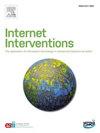使用大麻和阿片类药物的慢性疼痛患者接受生态瞬间评估的预测因素
IF 4.1
2区 医学
Q1 HEALTH CARE SCIENCES & SERVICES
Internet Interventions-The Application of Information Technology in Mental and Behavioural Health
Pub Date : 2024-10-26
DOI:10.1016/j.invent.2024.100784
引用次数: 0
摘要
背景大麻可以替代或辅助阿片类药物治疗慢性疼痛。然而,有关阿片类药物和医用大麻使用模式的数据十分有限。本研究调查了使用生态瞬间评估(EMA)评估慢性疼痛患者处方阿片类药物和医用大麻使用模式的可行性。参与者平均年龄为 42.6 岁(SD = 13.9),大多数为男性(57.9%)和非西班牙裔白人(63.2%)。参与者完成了基线评估,随后进行了为期 30 天的 EMA 数据收集,包括四次随机提示的过去小时调查和一次每日日记,以及一次评估 EMA 负担感知的后续调查。对简单和多变量线性回归模型进行了估算,以调查参与者完成 EMA 调查比例的预测因素(过去小时调查和每日日记在不同的模型中)。在多变量回归中,与拥有 4 年以下学位的参与者相比,拥有研究生学位的参与者完成每日日记(b = -0.109,SE = 0.052,p < .05)和过去小时调查(b = -0.148,SE = 0.071,p < .05)的比例较低。研究结果证实了使用 EMA 方法评估慢性疼痛患者处方阿片类药物和医用大麻使用模式的可行性。本文章由计算机程序翻译,如有差异,请以英文原文为准。
Predictors of participant compliance with ecological momentary assessment among individuals with chronic pain who are using cannabis and opioids
Background
Cannabis may be an alternative or adjunct to opioid therapy for chronic pain. However, there are limited data on patterns of opioid medication and medical cannabis use. The current study investigated the feasibility of using Ecological Momentary Assessment (EMA) to assess patterns of prescription opioids and medical cannabis among individuals experiencing chronic pain.
Method
The study included 133 participants recruited online. Participants were 42.6 (SD = 13.9) years old on average and the majority were men (57.9 %) and Non-Hispanic White (63.2 %). Participants completed a baseline assessment, followed by 30 days of EMA data collection with four randomly prompted past-hour surveys and one daily diary per day, and a follow-up survey that assessed perceived EMA burden. Simple and multivariable linear regression models were estimated to investigate participant predictors of the proportion of EMA surveys completed (past-hour surveys and daily diaries in separate models).
Results
Compliance rates for EMA prompts were 89.7 % for daily diaries and 63.3 % for past-hour surveys. In multivariable regression, participants holding a graduate degree completed a lower proportion of daily diaries (b = −0.109, SE = 0.052, p < .05) and past-hour surveys (b = −0.148, SE = 0.071, p < .05), compared to those with less than a 4-year degree. Participants completing a higher proportion of daily diaries reported greater ease of use at follow-up (b = 0.050, SE = 0.022, p < .05) and those completing a higher proportion of past-hour surveys desired higher rewards (b = 0.066, SE = 0.033, p < .05).
Conclusions
Study results confirm the feasibility of using EMA methods to assess patterns of prescription opioids and medical cannabis among individuals experiencing chronic pain.
求助全文
通过发布文献求助,成功后即可免费获取论文全文。
去求助
来源期刊

Internet Interventions-The Application of Information Technology in Mental and Behavioural Health
Medicine-Health Informatics
CiteScore
6.50
自引率
9.30%
发文量
94
审稿时长
6 weeks
期刊介绍:
Official Journal of the European Society for Research on Internet Interventions (ESRII) and the International Society for Research on Internet Interventions (ISRII).
The aim of Internet Interventions is to publish scientific, peer-reviewed, high-impact research on Internet interventions and related areas.
Internet Interventions welcomes papers on the following subjects:
• Intervention studies targeting the promotion of mental health and featuring the Internet and/or technologies using the Internet as an underlying technology, e.g. computers, smartphone devices, tablets, sensors
• Implementation and dissemination of Internet interventions
• Integration of Internet interventions into existing systems of care
• Descriptions of development and deployment infrastructures
• Internet intervention methodology and theory papers
• Internet-based epidemiology
• Descriptions of new Internet-based technologies and experiments with clinical applications
• Economics of internet interventions (cost-effectiveness)
• Health care policy and Internet interventions
• The role of culture in Internet intervention
• Internet psychometrics
• Ethical issues pertaining to Internet interventions and measurements
• Human-computer interaction and usability research with clinical implications
• Systematic reviews and meta-analysis on Internet interventions
 求助内容:
求助内容: 应助结果提醒方式:
应助结果提醒方式:


